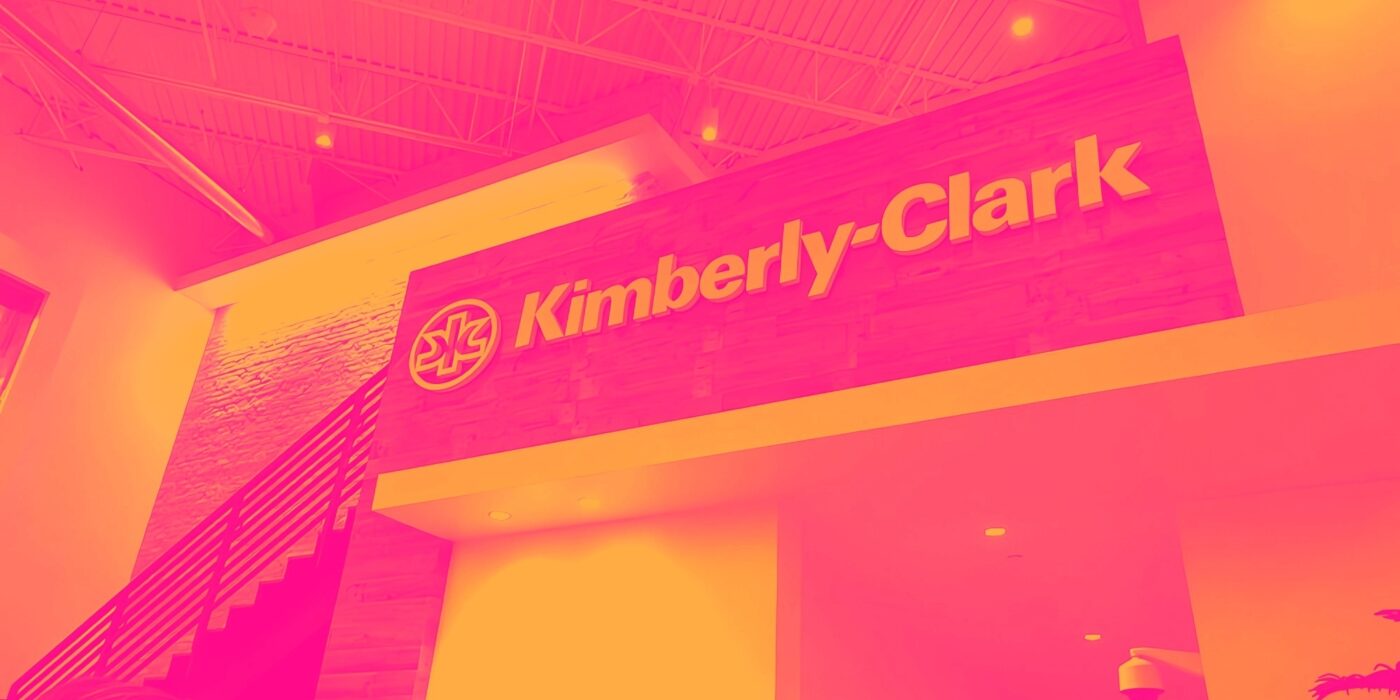Household products company Kimberly-Clark (NYSE:KMB) reported Q1 CY2024 results exceeding Wall Street analysts' expectations, with revenue flat year on year at $5.15 billion. It made a non-GAAP profit of $2.01 per share, improving from its profit of $1.67 per share in the same quarter last year.
Kimberly-Clark (KMB) Q1 CY2024 Highlights:
- Revenue: $5.15 billion vs analyst estimates of $5.09 billion (1.2% beat)
- EPS (non-GAAP): $2.01 vs analyst estimates of $1.64 (22.5% beat)
- 2024 guidance raised for organic net sales, adjusted operating profit, and adjusted EPS
- Gross Margin (GAAP): 37.1%, up from 33.2% in the same quarter last year
- Free Cash Flow of $244 million, down 75.6% from the previous quarter
- Organic Revenue was up 6% year on year
- Sales Volumes were up 1% year on year
- Market Capitalization: $43.44 billion
Originally founded as a Wisconsin paper mill in 1872, Kimberly-Clark (NYSE:KMB) is now a household products powerhouse known for personal care and tissue products.
Huggies, Pull-Ups, Kleenex, Scott, and Depends are some of the company’s iconic brands in baby care, tissue and paper products, and adult hygiene. Kimberly-Clark also has a robust professional business that sells products such as paper towels to large enterprises and business customers.
Kimberly-Clark uniquely serves customers throughout their entire lives. From the moment they’re born, infants and babies rely on the company’s diapers and pull-ups. Children and adults alike are consumers of Kimberly-Clark’s tissues, toilet paper, and paper towels. In their advanced age, many older folks are users of the company’s adult diapers. No matter their age, core customers want cost-effective products, although many are willing to pay a reasonable premium to buy established brands rather than lesser-known or private-label brands.
Kimberly-Clark products are almost ubiquitous. Grocery stores, mass merchandise retailers, drug stores, and specialty retailers typically all sell the company’s products. Given Kimberly-Clark’s scale in its categories and traffic-driving brands, the company often enjoys advantaged placement on retailer shelves.
Household Products
Household products stocks are generally stable investments, as many of the industry's products are essential for a comfortable and functional living space. Recently, there's been a growing emphasis on eco-friendly and sustainable offerings, reflecting the evolving consumer preferences for environmentally conscious options. These trends can be double-edged swords that benefit companies who innovate quickly to take advantage of them and hurt companies that don't invest enough to meet consumers where they want to be with regards to trends.
Competitors that offer a wide range of household and personal care products include Proctor & Gamble (NYSE:PG), Unilever (LSE:ULVR), and Church & Dwight (NYSE:CHD).Sales Growth
Kimberly-Clark is one of the most widely recognized consumer staples companies in the world. Its influence over consumers gives it extremely high negotiating leverage with distributors, enabling it to pick and choose where it sells its products (a luxury many don't have).
As you can see below, the company's annualized revenue growth rate of 2.6% over the last three years was weak as consumers bought less of its products. We'll explore what this means in the "Volume Growth" section.
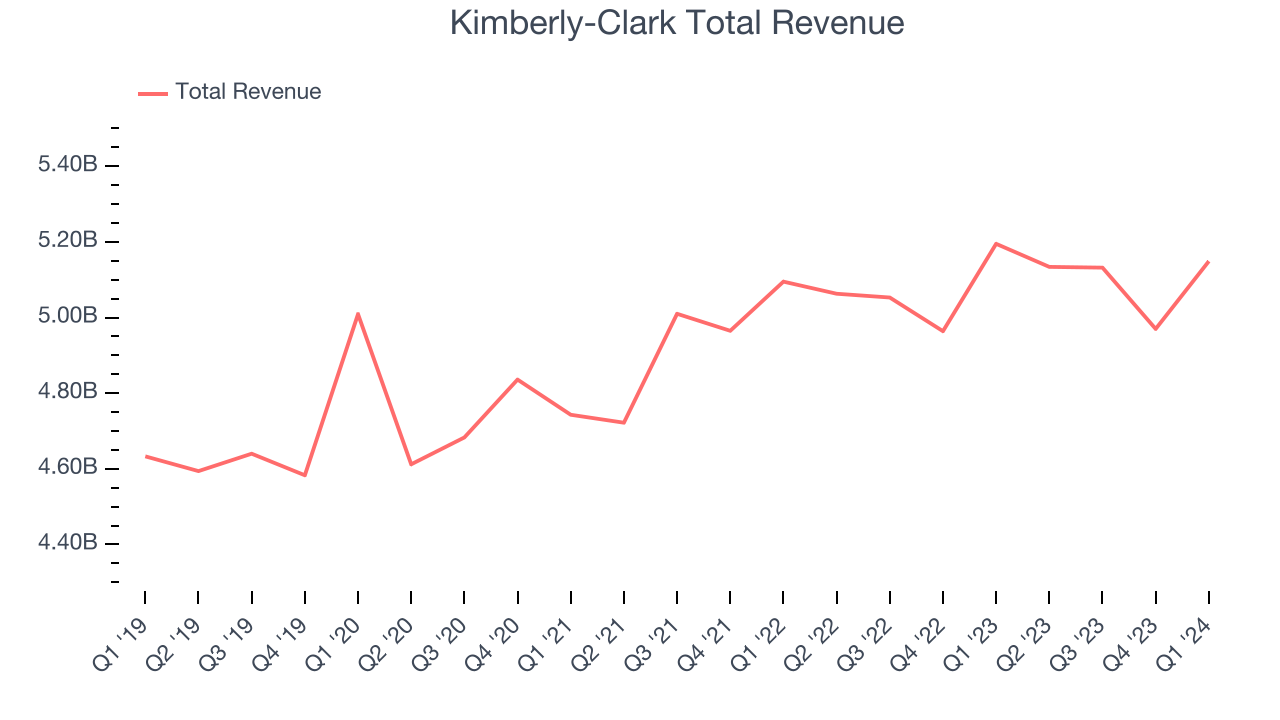
This quarter, Kimberly-Clark's revenue fell 0.9% year on year to $5.15 billion but beat Wall Street's estimates by 1.2%. Looking ahead, Wall Street expects revenue to remain flat over the next 12 months.
Volume Growth
Revenue growth can be broken down into changes in price and volume (the number of units sold). While both are important, volume is the lifeblood of a successful staples business as there’s a ceiling to what consumers will pay for everyday goods; they can always trade down to non-branded products if the branded versions are too expensive.
To analyze whether Kimberly-Clark generated its growth from changes in price or volume, we can compare its volume growth to its organic revenue growth, which excludes non-fundamental impacts on company financials like mergers and currency fluctuations.
Over the last two years, Kimberly-Clark's average quarterly sales volumes have shrunk by 2.4%. This decrease isn't ideal as the quantity demanded for consumer staples products is typically stable. Luckily, Kimberly-Clark was able to offset fewer customers purchasing its products by charging higher prices, enabling it to generate 5.6% average organic revenue growth. We hope the company can grow its volumes soon, however, as consistent price increases (on top of inflation) aren't sustainable over the long term unless the business is really really special.
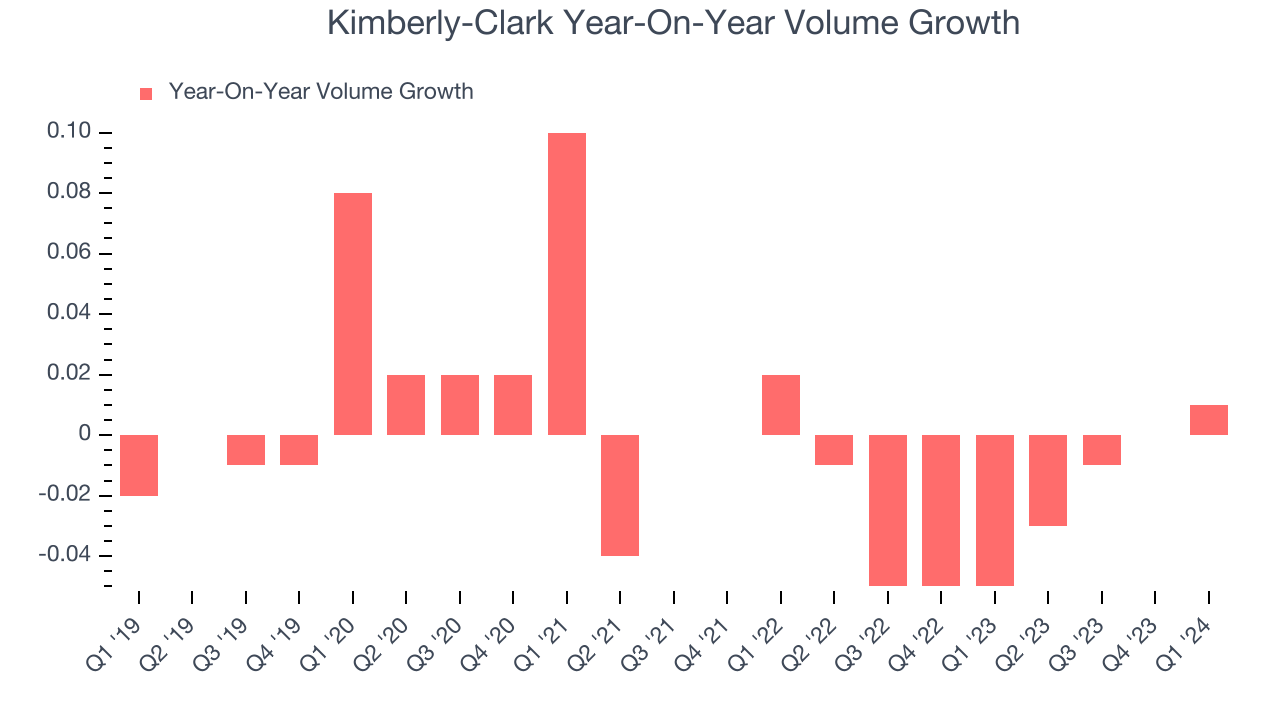
In Kimberly-Clark's Q1 2024, year on year sales volumes were flat. This result was a well-appreciated turnaround from the 5% year-on-year decline it posted 12 months ago, showing the company is heading in the right direction.
Gross Margin & Pricing Power
All else equal, we prefer higher gross margins. They make it easier to generate more operating profits and indicate that a company commands pricing power by offering more differentiated products.
Kimberly-Clark's gross profit margin came in at 37.1% this quarter, up 3.9 percentage points year on year. That means for every $1 in revenue, $0.63 went towards paying for raw materials, production of goods, and distribution expenses.
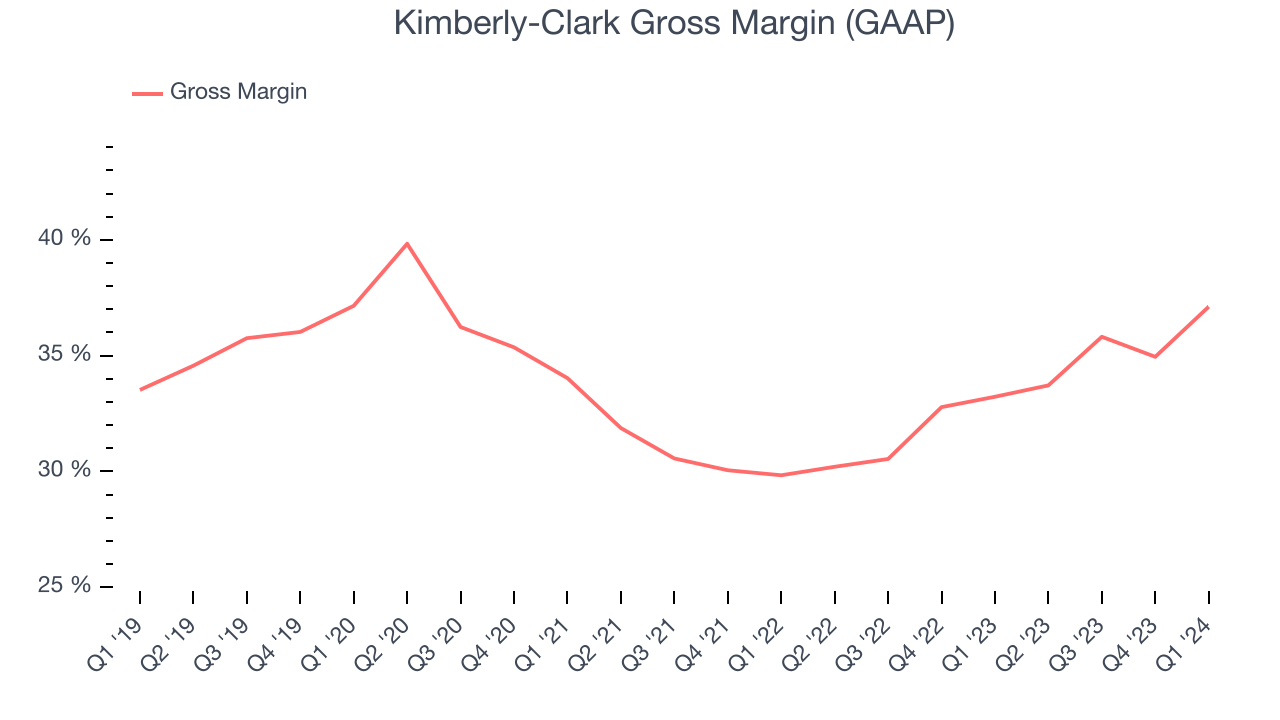
Kimberly-Clark's unit economics are higher than the typical consumer staples company, giving it the flexibility to invest in areas such as marketing and talent to reach more consumers. As you can see above, it's averaged a decent 33.6% gross margin over the last eight quarters. Its margin has also been trending up over the last 12 months, averaging 11.8% year-on-year increases each quarter. If this trend continues, it could suggest a less competitive environment where the company has better pricing power and more favorable input costs (such as raw materials).
Operating Margin
Operating margin is an important measure of profitability accounting for key expenses such as marketing and advertising, IT systems, wages, and other administrative costs.
This quarter, Kimberly-Clark generated an operating profit margin of 16.6%, up 1.4 percentage points year on year. This increase was solid and driven by stronger pricing power and lower raw materials/transportation costs, as indicated by the company's larger rise in gross margin.
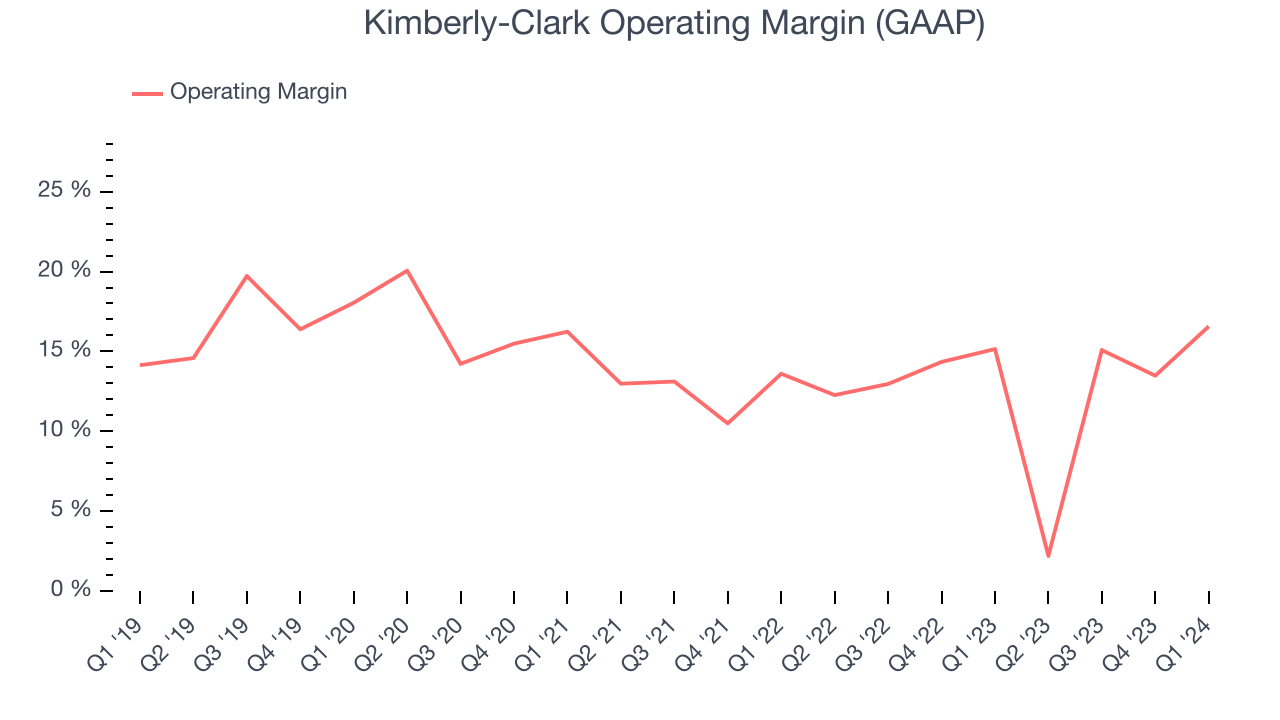 Zooming out, Kimberly-Clark has managed its expenses well over the last two years. It's demonstrated solid profitability for a consumer staples business, producing an average operating margin of 12.8%. However, Kimberly-Clark's margin has declined by 1.9 percentage points on average over the last year. Although this isn't the end of the world, investors are likely hoping for better results in the future.
Zooming out, Kimberly-Clark has managed its expenses well over the last two years. It's demonstrated solid profitability for a consumer staples business, producing an average operating margin of 12.8%. However, Kimberly-Clark's margin has declined by 1.9 percentage points on average over the last year. Although this isn't the end of the world, investors are likely hoping for better results in the future. EPS
These days, some companies issue new shares like there's no tomorrow. That's why we like to track earnings per share (EPS) because it accounts for shareholder dilution and share buybacks.
In Q1, Kimberly-Clark reported EPS at $2.01, up from $1.67 in the same quarter a year ago. This print beat Wall Street's estimates by 22.5%.

Between FY2021 and FY2024, Kimberly-Clark's EPS dropped 6.7%, translating into 2.3% annualized declines. We tend to steer our readers away from companies with falling EPS, especially in the consumer staples sector, where shrinking earnings could imply changing secular trends or consumer preferences. If there's no earnings growth, it's difficult to build confidence in a business's underlying fundamentals, leaving a low margin of safety around the company's valuation (making the stock susceptible to large downward swings).
Earnings stability could be coming, however, as Wall Street is projecting Kimberly-Clark's EPS to stay flat over the next 12 months.
Cash Is King
Although earnings are undoubtedly valuable for assessing company performance, we believe cash is king because you can't use accounting profits to pay the bills.
Kimberly-Clark's free cash flow came in at $244 million in Q1, down 40.8% year on year. This result represents a 4.7% margin.
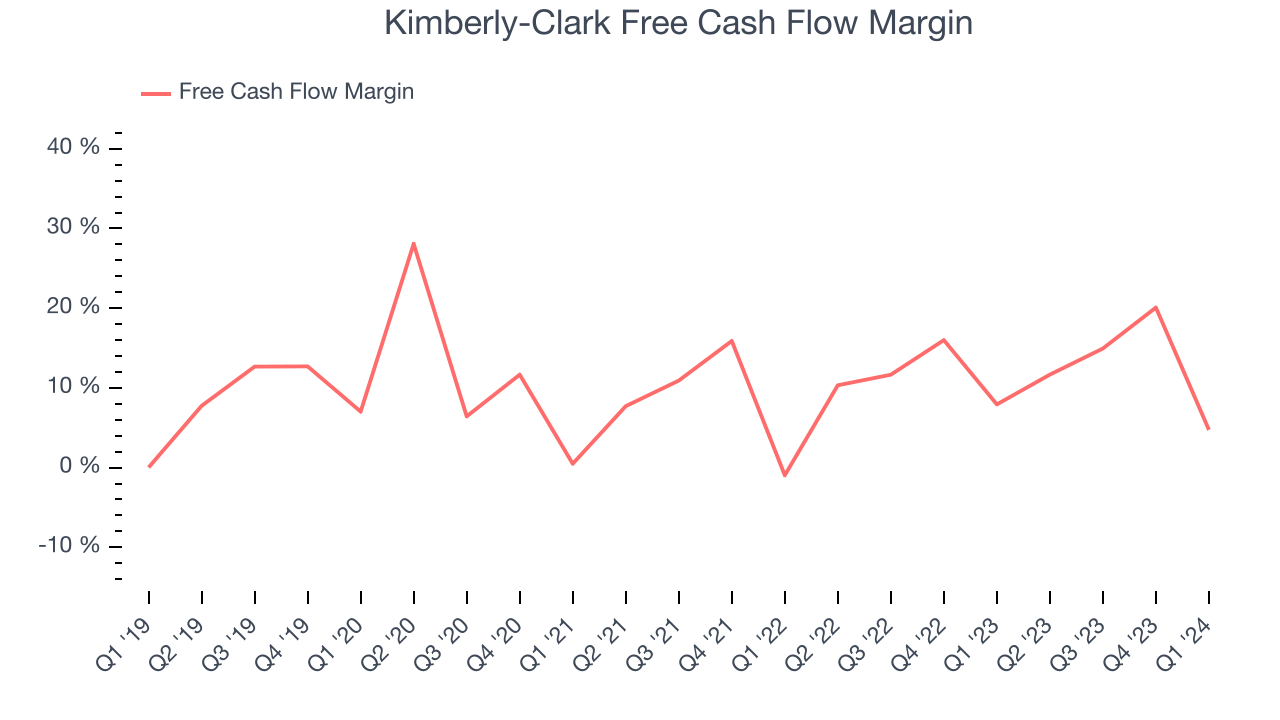
Over the last two years, Kimberly-Clark has shown strong cash profitability, giving it an edge over its competitors and the option to reinvest or return capital to investors while keeping cash on hand for emergencies. The company's free cash flow margin has averaged 12.1%, quite impressive for a consumer staples business. Furthermore, its margin has averaged year-on-year increases of 1.4 percentage points over the last 12 months. This likely pleases the company's investors.
Return on Invested Capital (ROIC)
EPS and free cash flow tell us whether a company was profitable while growing revenue. But was it capital-efficient? A company’s ROIC explains this by showing how much operating profit a company makes compared to how much money the business raised (debt and equity).
Kimberly-Clark's five-year average ROIC was 30.3%, placing it among the best consumer staples companies. Just as you’d like your investment dollars to generate returns, Kimberly-Clark's invested capital has produced excellent profits.
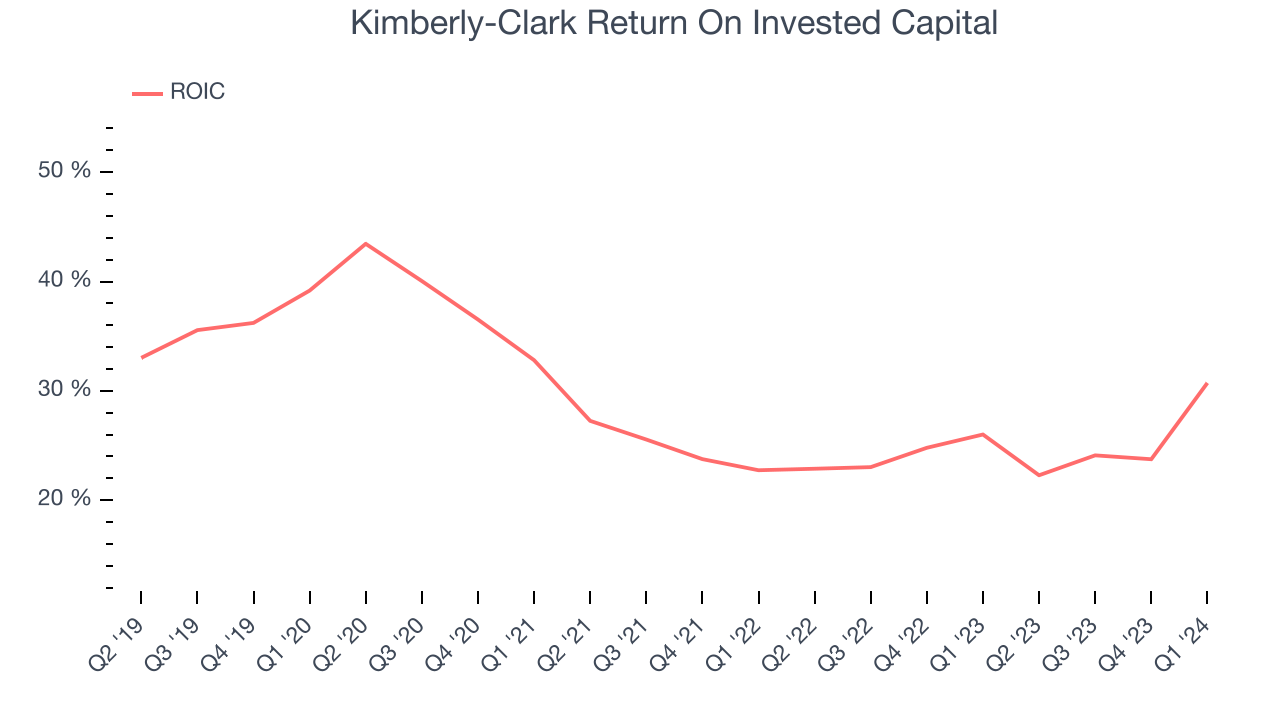
The trend in its ROIC, however, is often what surprises the market and drives the stock price. Unfortunately, Kimberly-Clark's ROIC averaged 7.6 percentage point decreases over the last few years. We like what management has done historically but are concerned its ROIC is declining, perhaps a symptom of waning business opportunities to invest profitably.
Balance Sheet Risk
As long-term investors, the risk we care most about is the permanent loss of capital. This can happen when a company goes bankrupt or raises money from a disadvantaged position and is separate from short-term stock price volatility, which we are much less bothered by.
Kimberly-Clark reported $1.66 billion of cash and $7.17 billion of debt on its balance sheet in the most recent quarter. As investors in high-quality companies, we primarily focus on two things: 1) that a company's debt level isn't too high and 2) that its interest payments are not excessively burdening the business.
With $3.77 billion of EBITDA over the last 12 months, we view Kimberly-Clark's 1.5x net-debt-to-EBITDA ratio as safe. We also see its $104 million of annual interest expenses as appropriate. The company's profits give it plenty of breathing room, allowing it to continue investing in new initiatives.
Key Takeaways from Kimberly-Clark's Q1 Results
We were impressed by how significantly Kimberly-Clark blew past analysts' organic revenue growth expectations this quarter. We were also excited its gross margin outperformed Wall Street's estimates. Looking forward, full year guidance was raised for major line items such as organic sales, adjusted operating profit, and adjusted EPS. Zooming out, we think this was an impressive quarter that should delight shareholders. The stock is up 2.5% after reporting and currently trades at $132.05 per share.
Is Now The Time?
Kimberly-Clark may have had a good quarter, but investors should also consider its valuation and business qualities when assessing the investment opportunity.
We have other favorites, but we understand the arguments that Kimberly-Clark isn't a bad business. Although its revenue growth has been uninspiring over the last three years with analysts expecting growth to slow from here, its stellar ROIC suggests it has been a well-run company historically. Investors should still be cautious, however, as its shrinking sales volumes suggest it'll need to change its strategy to succeed.
Kimberly-Clark's price-to-earnings ratio based on the next 12 months is 18.5x. In the end, beauty is in the eye of the beholder. While Kimberly-Clark wouldn't be our first pick, if you like the business, the shares are trading at a pretty interesting price right now.
Wall Street analysts covering the company had a one-year price target of $131.77 per share right before these results (compared to the current share price of $132.05).
To get the best start with StockStory, check out our most recent stock picks, and then sign up to our earnings alerts by adding companies to your watchlist here. We typically have the quarterly earnings results analyzed within seconds of the data being released, and especially for companies reporting pre-market, this often gives investors the chance to react to the results before the market has fully absorbed the information.
